 |
BusTalk
A Community Discussing Buses and Bus Operations Worldwide!
|
| View previous topic :: View next topic |
| Author |
Message |
Free-transfer
Age: 64
Joined: 16 May 2007
Posts: 123
Location: South Florida
|
 Posted: Fri Sep 19, 2014 10:40 pm Post subject: Posted: Fri Sep 19, 2014 10:40 pm Post subject: |
 |
|
| The street sign seems to indicate E. 60 street. |
|
| Back to top |
|
 |
Mr. Linsky
BusTalk's Offical Welcoming Committee

Joined: 16 Apr 2007
Posts: 5071
Location: BRENTWOOD, CA. - WOODMERE, N.Y.
|
 Posted: Sat Sep 20, 2014 11:49 am Post subject: Posted: Sat Sep 20, 2014 11:49 am Post subject: |
 |
|
| Free-transfer wrote: | | The street sign seems to indicate E. 60 street. |
Free-transfer,
You are correct - I couldn't make out the sign in my picture.
East 60th. makes sense because the FACCO #15 line from Jackson Heights would come off the bridge to 60th. and across to 5th. on its way to 25th.
Thanks for the correction.
Best regards,
Mr. 'L' |
|
| Back to top |
|
 |
Mr. Linsky
BusTalk's Offical Welcoming Committee

Joined: 16 Apr 2007
Posts: 5071
Location: BRENTWOOD, CA. - WOODMERE, N.Y.
|
 Posted: Sat Sep 27, 2014 3:57 pm Post subject: Posted: Sat Sep 27, 2014 3:57 pm Post subject: |
 |
|
You might call this report a double header because not only does it spotlight a great shot of what was left of a prewar Brooklyn coach still in service for the city in the late forties but also a glimpse at the backbone of New York's innovative refuse collection equipment of the same era.
Seen in route on the #11 line heading for 18th. Avenue in the Borough Park section of Kings County is fleet # 725 - a 1936 30 passenger ACF modeled as an H-13-S and one of thirty likenesses numbered 700 to 729 originally purchased and operated for BMT affiliate Brooklyn Bus Corporation.
Taking over the Brooklyn Bus operation in 1940, which was reputed to be the largest of its kind in the country at the time, New York City did order and receive nearly 250 Twin Coaches in 1941 but not nearly enough to replace all of the inherited and antiquated prewar equipment in the borough and #725 and its ilk certainly show the scars left by the minimum maintenance that they received before their eventual retirement.
Our co-focus - a 1934 GMC modeled as a T-75 'COE' chassis and carrying an exclusive 'escalator loader' body by either Gar Wood Industries or The Heil Company, was one of 615 units ordered to augment a similar number of 1933 Autocar model U's making New York City the largest and best equipped sanitation department in the country - a record that I believe still stands.
Of note on # 320-460 (special license plates provided truck fleet numbers) is the plowing rig and a clever door locking mechanism!
The 'escalator loader' which was akin to a moving stairway that carried rubbish up a chute into the body, was designed by city engineers with the story on that below;
In between the first self-loading refuse bodies which appeared in the late 1920s, and the first American compactor trucks of the late 1930s lies an almost forgotten chapter in the evolution of refuse collection referred to as the 'escalator loader'.
The escalator-loader, the brainchild of New York City Department of Sanitation (DSNY) engineers was, for nearly two decades, the mainstay of the Department's fleet.
Though designed by the DSNY, these new units were to be built in collaboration with the country's two biggest truck body manufacturers, Gar Wood Industries and The Heil Company. These rivals competed for DSNY contracts, building nearly identical versions between 1937 and about 1947. Though relatively short-lived, the sheer numbers of escalator-loaders ordered by the Department may have single-handedly jump-started the U.S. refuse body industry, and set the stage for intense technical competition among the major manufacturers.
Upper photo courtesy of 'Vintage-Vault75' and is available at eBay as item # 171474991820.
Lower photo and some information courtesy of Hanks Trucks.
Mr. Linsky - Green Bus Lines, Inc., Jamaica, New York
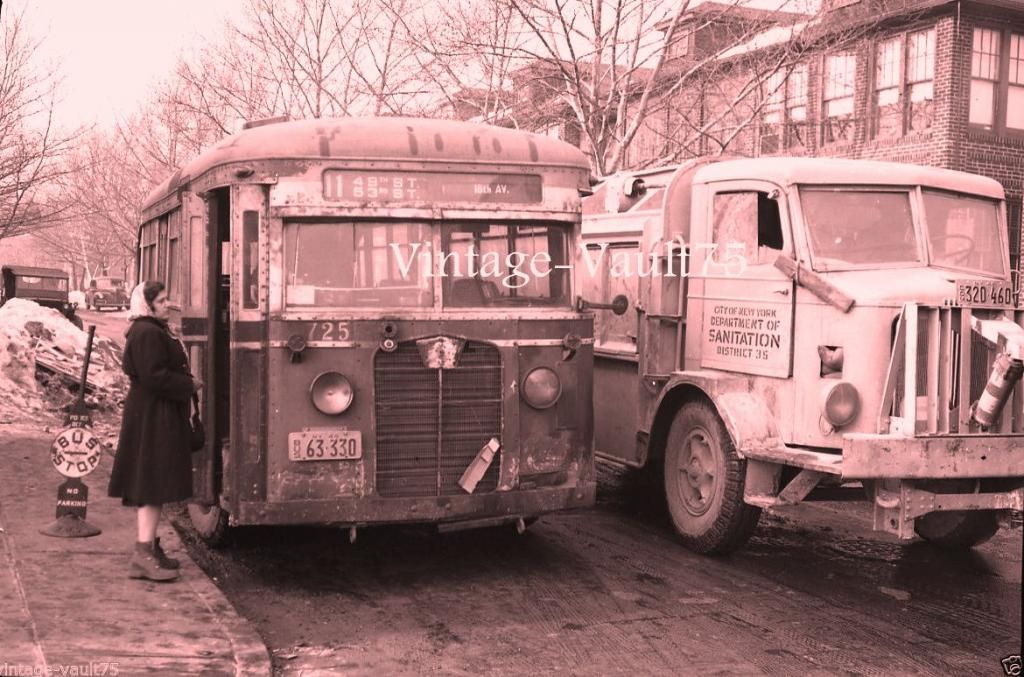
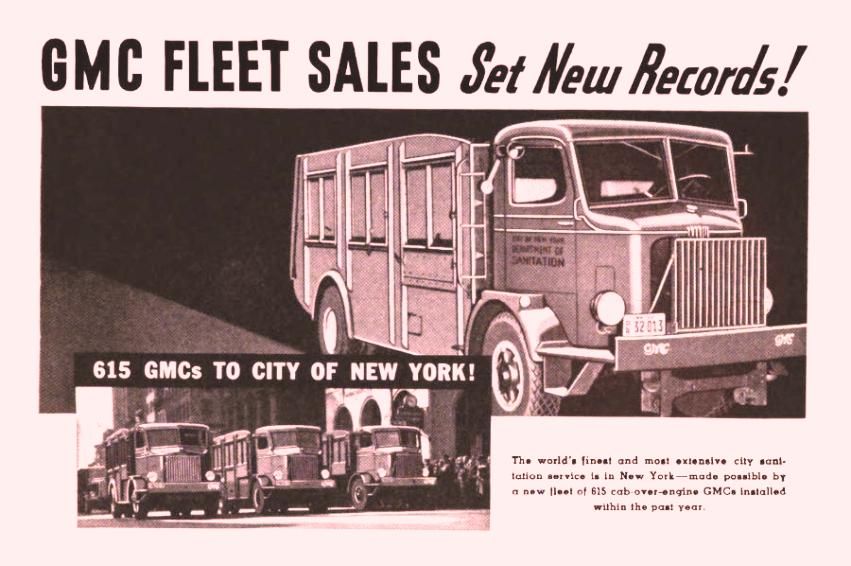 |
|
| Back to top |
|
 |
W.B. Fishbowl
Age: 57
Joined: 02 Oct 2014
Posts: 2422
Location: New York, New York, USA
|
 Posted: Thu Oct 02, 2014 11:36 am Post subject: Posted: Thu Oct 02, 2014 11:36 am Post subject: |
 |
|
| Mr. Linsky wrote: | It's noon time Manhattan on a cloudy summer day in 1965 (a time frame that you won't need a slide rule to figure out) as we see fleet # 3471 - a 1963 GM Model TDH 5303 and one of 250 delivered to the Manhattan and Bronx Surface Transit Operating Authority (MaBSTOA) in that year.
# 3471 is picking up passengers between 49th. and 50th. Street on 5th. Avenue and is heading south bound on the #5 Line to Washington Square.
The young lady at the head of the waiting line and partially hidden by the lamp post is Marlo Thomas (Danny's daughter) and is filming a scene for 'That Girl' - a situation comedy from Desilu Studios in which Ms. Thomas was the star between 1966 and 1971.
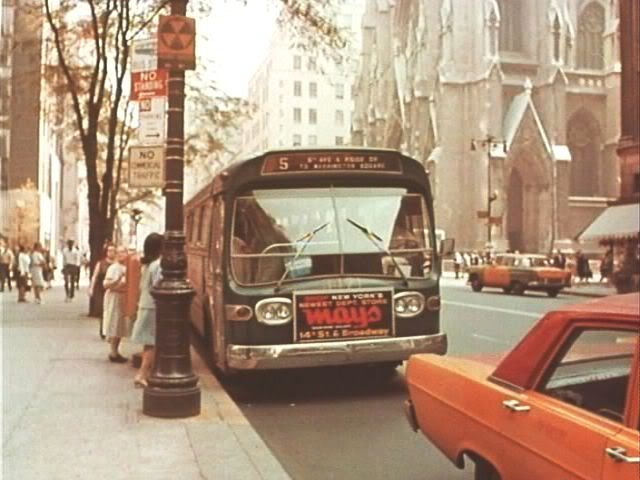 |
It also appears to bear the "old-style" 1950's street signs with the main street at top and the intersecting one at bottom; around the time Fifth Avenue went one-way southbound, the newer "color-coded" street signs that the Dept. of Traffic began instituting in 1964, came to that southwest corner of Fifth and 50th. |
|
| Back to top |
|
 |
Mr. Linsky
BusTalk's Offical Welcoming Committee

Joined: 16 Apr 2007
Posts: 5071
Location: BRENTWOOD, CA. - WOODMERE, N.Y.
|
 Posted: Thu Oct 02, 2014 4:46 pm Post subject: Posted: Thu Oct 02, 2014 4:46 pm Post subject: |
 |
|
No, your eyes are not deceiving you - seen below in Brooklyn in early 1948 and in full Fifth Avenue Coach regalia working the #47 Tompkins Avenue line is fleet # 2500 - a 1940 55 passenger Yellow Coach originally modeled as a TD-5501.
As early as 1939 the Chicago based Omnibus Corporation, parent to both Fifth Avenue Coach and Chicago Motor Coach, began work in concert with Yellow Coach engineers to conceive the largest practical single deck bus to replace the company's flagship double decked fleets which were becoming too expensive to operate and maintain.
Dubbed by Yellow as demo EXP-204, the 43 foot long coach clad in the familiar Omnibus two tone green and cream livery toured the country with no takers until the war when it was both stored and altered to a TD-5401 to meet New York regulations governing access to emergency doors.
Post war saw #2500 back on the road and eventually reaching New York's Brooklyn Bus Division in 1947 after which trials at Fifth Avenue Coach resulted in its purchase in 1948 but not before the body was cut down by one window bringing its maximum length to 40 feet which remodeled it as a TD-5001.
I have no doubt that this rare one of a kind specimen would have eventually found a home at the MTA Museum had it not been destroyed by fire in Westchester in 1968.
Photo courtesy of 'Vintage-Vauly75' and is available at eBay as item # 171474986693.
Mr. Linsky - Green Bus Lines, Inc, Jamaica, New York
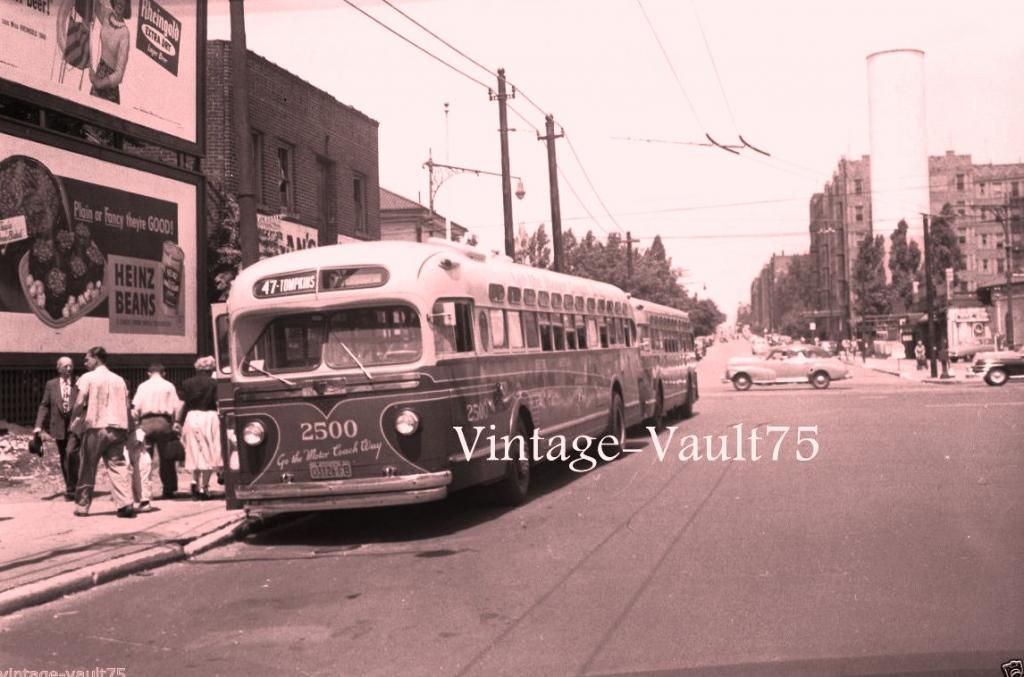 |
|
| Back to top |
|
 |
N4 Jamaica

Joined: 16 Apr 2007
Posts: 858
Location: Long Island
|
 Posted: Thu Oct 02, 2014 5:26 pm Post subject: Posted: Thu Oct 02, 2014 5:26 pm Post subject: |
 |
|
Thanks for posting the interesting scene. The following is a link to a page detailing the stages of conversion of Brooklyn trolley routes to trackless trolley routes with an interim stage as bus lines:
http://bus.nycsubway.org/trackless.html
---
Buses replaced Tompkins Avenue streetcars on August 24, 1947. Trolley coaches (trackless trolleys or trolleybuses) replaced the buses on November 19, 1948. I suspect that the long delay was the decision to replace the streetcar wire with trackless wire while streetcars were not in service. At the time, much was made of the fact that Board of Transportation employees, not contractors, did the rewiring. Also, if memory is correct, the curved section shown in your photo was something new produced by Ohio Brass Co. Streetcar wire on curves was connected by many more horizontal stringers to form the curve, but the Board chose these solid curves in the sky. They fascinated me when I first saw them on Livingston Street.
---
For the life of me, I cannot locate the scene. Could it be Washington Avenue at Empire Blvd.?
Joe |
|
| Back to top |
|
 |
Mr. Linsky
BusTalk's Offical Welcoming Committee

Joined: 16 Apr 2007
Posts: 5071
Location: BRENTWOOD, CA. - WOODMERE, N.Y.
|
 Posted: Fri Oct 03, 2014 1:44 am Post subject: Posted: Fri Oct 03, 2014 1:44 am Post subject: |
 |
|
| N4 Jamaica wrote: | Thanks for posting the interesting scene. The following is a link to a page detailing the stages of conversion of Brooklyn trolley routes to trackless trolley routes with an interim stage as bus lines:
http://bus.nycsubway.org/trackless.html
---
Buses replaced Tompkins Avenue streetcars on August 24, 1947. Trolley coaches (trackless trolleys or trolleybuses) replaced the buses on November 19, 1948. I suspect that the long delay was the decision to replace the streetcar wire with trackless wire while streetcars were not in service. At the time, much was made of the fact that Board of Transportation employees, not contractors, did the rewiring. Also, if memory is correct, the curved section shown in your photo was something new produced by Ohio Brass Co. Streetcar wire on curves was connected by many more horizontal stringers to form the curve, but the Board chose these solid curves in the sky. They fascinated me when I first saw them on Livingston Street.
---
For the life of me, I cannot locate the scene. Could it be Washington Avenue at Empire Blvd.?
Joe |
Joe,
I've got another interesting question about the photo;
What is the extremely tall white cylindrical structure standing upper right of frame?
I wish I could help you on the exact location of the image but I'm not that familiar with most of Brooklyn and the accompanying caption was of no help at all.
Regards,
Mr. 'L' |
|
| Back to top |
|
 |
X-Astorian
Joined: 19 Feb 2009
Posts: 168
Location: Central NJ
|
 Posted: Fri Oct 03, 2014 7:51 am Post subject: Posted: Fri Oct 03, 2014 7:51 am Post subject: |
 |
|
| N4 Jamaica wrote: | Thanks for posting the interesting scene. The following is a link to a page detailing the stages of conversion of Brooklyn trolley routes to trackless trolley routes with an interim stage as bus lines:
http://bus.nycsubway.org/trackless.html
---
Buses replaced Tompkins Avenue streetcars on August 24, 1947. Trolley coaches (trackless trolleys or trolleybuses) replaced the buses on November 19, 1948. I suspect that the long delay was the decision to replace the streetcar wire with trackless wire while streetcars were not in service. At the time, much was made of the fact that Board of Transportation employees, not contractors, did the rewiring. Also, if memory is correct, the curved section shown in your photo was something new produced by Ohio Brass Co. Streetcar wire on curves was connected by many more horizontal stringers to form the curve, but the Board chose these solid curves in the sky. They fascinated me when I first saw them on Livingston Street.
---
For the life of me, I cannot locate the scene. Could it be Washington Avenue at Empire Blvd.?
Joe |
You called it - that's just where it is (to my eye). |
|
| Back to top |
|
 |
N4 Jamaica

Joined: 16 Apr 2007
Posts: 858
Location: Long Island
|
 Posted: Fri Oct 03, 2014 10:27 am Post subject: Posted: Fri Oct 03, 2014 10:27 am Post subject: |
 |
|
Yes. The more I try to figure out that cylindrical tower, the more certain I am that the view looks north on Washington Avenue to Empire Blvd and, beyond that, to Sullivan Place. Maybe the tower supplied water to the Botanic Garden, as I have come across other much older photos of a stone water tower near Prospect Park. The location may be at the lower edge of the terminal moraine that Washington Avenue climbs.
---
Edit: I have come across the cylinder in this 1916 view east across Flatbush Avenue towards Ebbets Field. A Fire Department signal station is to the right. The caption says this view is across Botanic Garden, but this property is only the southern tip of the Garden property.
Link:
http://www.brooklynpix.com/photoframex1.php?photo=/photo1/E/ebbets201.jpg&key=EBBETS%20201
---
And the tower appears in a 1924 aerial view of the northeast corner of Sullivan Place and Washington Avenue.
Source of aerial views:
http://gis.nyc.gov/doitt/nycitymap/
Joe |
|
| Back to top |
|
 |
N4 Jamaica

Joined: 16 Apr 2007
Posts: 858
Location: Long Island
|
 Posted: Fri Oct 03, 2014 4:46 pm Post subject: Posted: Fri Oct 03, 2014 4:46 pm Post subject: |
 |
|
The New York Times's excellent search engine has come to the rescue. An article dated April 4, 1950, explains that the water tower, in use since before 1881, was sold by the New York Water Service Corp., which had used it to maintain water pressure. It was to be demolished and the property to be improved.
---
I am rather certain that this is the same water company that extended "public utility water" through Merrick, Bellmore, Wantagh, and Seaford post World War II. The rates are considerably higher than the rates charged in governmental water districts east and west of us. New York Water Service Corp. has been replaced twice by nationwide companies. The Wantagh Fire District complains about their charge of hundreds of dollars per hydrant.
---
In 1996, New York City bought out the Jamaica Water Supply Company. (Sorry for this off-topic meandering.)
Joe |
|
| Back to top |
|
 |
Mr. Linsky
BusTalk's Offical Welcoming Committee

Joined: 16 Apr 2007
Posts: 5071
Location: BRENTWOOD, CA. - WOODMERE, N.Y.
|
 Posted: Sat Oct 04, 2014 2:19 am Post subject: Posted: Sat Oct 04, 2014 2:19 am Post subject: |
 |
|
| N4 Jamaica wrote: | The New York Times's excellent search engine has come to the rescue. An article dated April 4, 1950, explains that the water tower, in use since before 1881, was sold by the New York Water Service Corp., which had used it to maintain water pressure. It was to be demolished and the property to be improved.
---
I am rather certain that this is the same water company that extended "public utility water" through Merrick, Bellmore, Wantagh, and Seaford post World War II. The rates are considerably higher than the rates charged in governmental water districts east and west of us. New York Water Service Corp. has been replaced twice by nationwide companies. The Wantagh Fire District complains about their charge of hundreds of dollars per hydrant.
---
In 1996, New York City bought out the Jamaica Water Supply Company. (Sorry for this off-topic meandering.)
Joe |
Joe,
I'm wondering what if anything the little City of New York brick and slate Pumping Stations seen every so often on the North side of Sunrise Highway as you head out East have to do with those towers?
There is supposed to be a large diameter water pipe (which is no longer in use) coming into Queens from out East hence the names North and South Conduit Avenues which trim the Belt Parkway through the Ozones toward Brooklyn.
BTW; that line may have worked in reverse with the city selling water to towns along the South Shore.
See what you can dig up.
Best regards,
Mr. 'L' |
|
| Back to top |
|
 |
N4 Jamaica

Joined: 16 Apr 2007
Posts: 858
Location: Long Island
|
|
| Back to top |
|
 |
Mr. Linsky
BusTalk's Offical Welcoming Committee

Joined: 16 Apr 2007
Posts: 5071
Location: BRENTWOOD, CA. - WOODMERE, N.Y.
|
 Posted: Mon Oct 06, 2014 1:06 pm Post subject: Posted: Mon Oct 06, 2014 1:06 pm Post subject: |
 |
|
In scanning New York City Archives I found a few very interesting candid shots at North Shore Bus Company taken in the mid thirties by photographer A. J. Foley of the City of New York Department of Plant and Structures.
In the top image we see some of the company's latest equipment on duty at their Flushing Terminal (of note is the price of a hot dog and an Orange drink).
In the middle shot, taken at North Shore's main shops, a State Public Service Commission inspector works with a company mechanic to certify a group of brand new Twin model 40-R's for road worthiness.
And in the bottom frame two mechanics are fine tuning door operations on new fleet # N700 - another of twenty five recently delivered 40-R's (note that a turnstile, which was used on all company buses, had yet to be installed).
Also of note on # N700 are the plush genuine leather seats and a generous use of stainless steel passenger railings.
Mr. Linsky - Green Bus Lines, Inc., Jamaica, New York

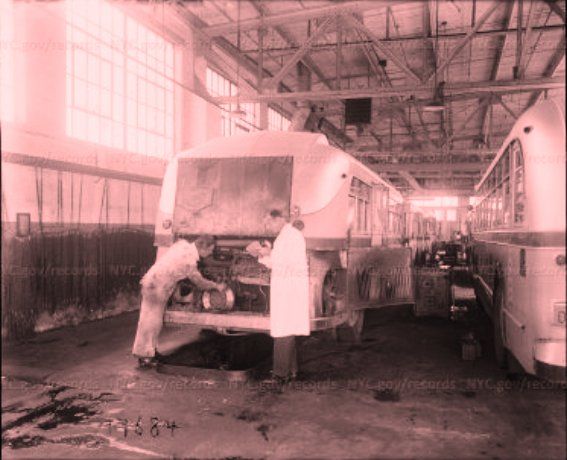
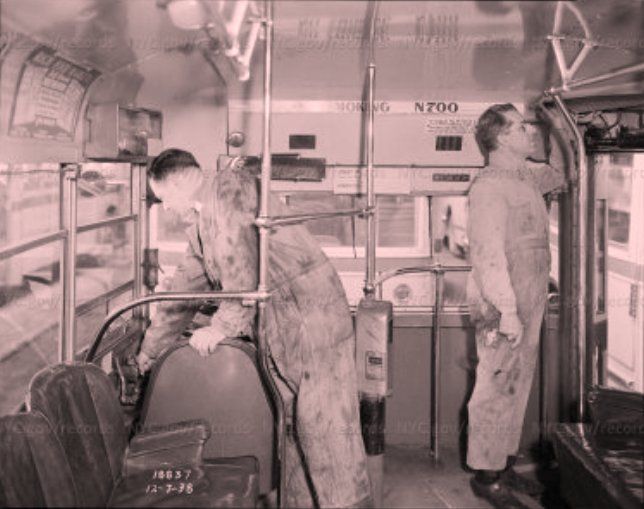 |
|
| Back to top |
|
 |
Q65A
Age: 66
Joined: 17 Apr 2007
Posts: 1769
Location: Central NJ
|
 Posted: Fri Oct 10, 2014 6:51 pm Post subject: Posted: Fri Oct 10, 2014 6:51 pm Post subject: |
 |
|
| Interesting that "Downtown Flushing" still has not yet had an off-street bus terminal to replace that old North Shore facility (which became a Gertz department store, as well as other tenants of that same tract). Only the 165th Street Terminal remains as the sole off-street bus terminal in Queens... |
|
| Back to top |
|
 |
Mr. Linsky
BusTalk's Offical Welcoming Committee

Joined: 16 Apr 2007
Posts: 5071
Location: BRENTWOOD, CA. - WOODMERE, N.Y.
|
 Posted: Sat Oct 11, 2014 1:12 am Post subject: Posted: Sat Oct 11, 2014 1:12 am Post subject: |
 |
|
| Q65A wrote: | | Interesting that "Downtown Flushing" still has not yet had an off-street bus terminal to replace that old North Shore facility (which became a Gertz department store, as well as other tenants of that same tract). Only the 165th Street Terminal remains as the sole off-street bus terminal in Queens... |
Bob,
The demise of most of the Queens bus terminals including Archer Avenue in Jamaica, Far Rockaway and I can assume Flushing as well came about by exorbitant rent increases and blackmail threats foisted upon bus companies by greedy landlords.
A case in point; the owner of the terminal at the railroad station in Far Rockaway threatened both Green and Nassau Bus Lines that if they didn't pay for repaving he would throw them out - P.S.; both company's immediately vacated and created curbside service around the corner.
In the case of Archer Avenue in Jamaica; the landlord raised to the rent outrageously high to discourage the four operators so that he could tear down the terminal to build something to bring in more income - here again curbside service was created.
I would have to conclude that the reason that new terminals have not been built is that the land is too valuable.
Regards,
Mr. 'L' |
|
| Back to top |
|
 |
|
|
You cannot post new topics in this forum
You cannot reply to topics in this forum
You cannot edit your posts in this forum
You cannot delete your posts in this forum
You cannot vote in polls in this forum
You can attach files in this forum
You can download files in this forum
|
Powered by phpBB © 2001, 2005 phpBB Group
|









